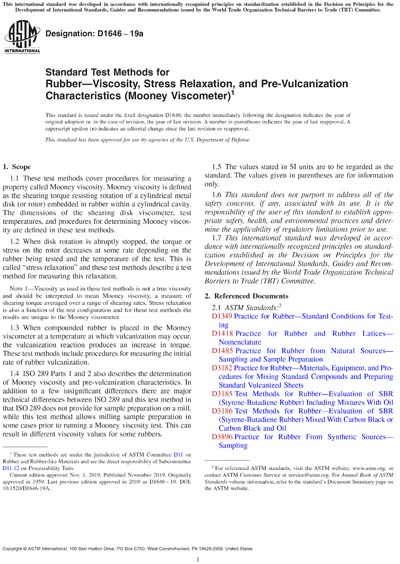Most recent
ASTM D1646-19a
Standard Test Methods for Rubber—Viscosity, Stress Relaxation, and Pre-Vulcanization Characteristics (Mooney Viscometer)
1.1 These test methods cover procedures for measuring a property called Mooney viscosity. Mooney viscosity is defined as the shearing torque resisting rotation of a cylindrical metal disk (or rotor) embedded in rubber within a cylindrical cavity. The dimensions of the shearing disk viscometer, test temperatures, and procedures for determining Mooney viscosity are defined in these test methods.
1.2 When disk rotation is abruptly stopped, the torque or stress on the rotor decreases at some rate depending on the rubber being tested and the temperature of the test. This is called “stress relaxation” and these test methods describe a test method for measuring this relaxation.
Note 1: Viscosity as used in these test methods is not a true viscosity and should be interpreted to mean Mooney viscosity, a measure of shearing torque averaged over a range of shearing rates. Stress relaxation is also a function of the test configuration and for these test methods the results are unique to the Mooney viscometer.
1.3 When compounded rubber is placed in the Mooney viscometer at a temperature at which vulcanization may occur, the vulcanization reaction produces an increase in torque. These test methods include procedures for measuring the initial rate of rubber vulcanization.
1.4 ISO 289 Parts 1 and 2 also describes the determination of Mooney viscosity and pre-vulcanization characteristics. In addition to a few insignificant differences there are major technical differences between ISO 289 and this test method in that ISO 289 does not provide for sample preparation on a mill, while this test method allows milling sample preparation in some cases prior to running a Mooney viscosity test. This can result in different viscosity values for some rubbers.
1.5 The values stated in SI units are to be regarded as the standard. The values given in parentheses are for information only.
1.6 This standard does not purport to address all of the safety concerns, if any, associated with its use. It is the responsibility of the user of this standard to establish appropriate safety, health, and environmental practices and determine the applicability of regulatory limitations prior to use.
1.7 This international standard was developed in accordance with internationally recognized principles on standardization established in the Decision on Principles for the Development of International Standards, Guides and Recommendations issued by the World Trade Organization Technical Barriers to Trade (TBT) Committee.
Content Provider
ASTM International [astm]






